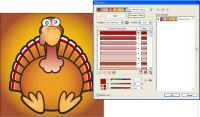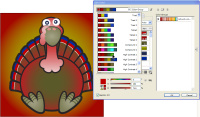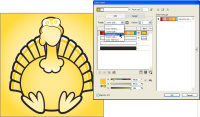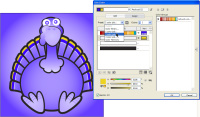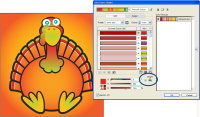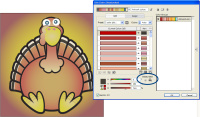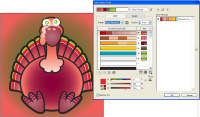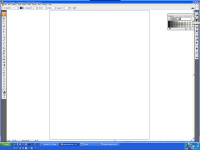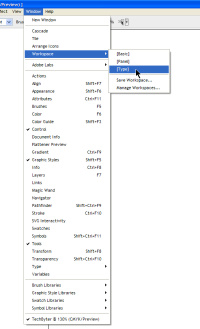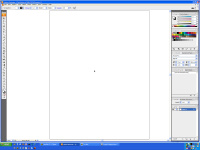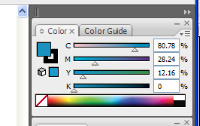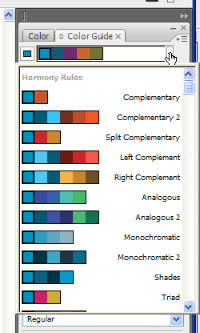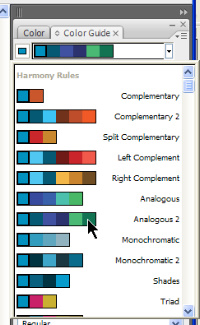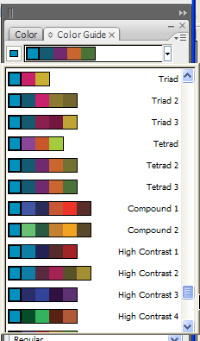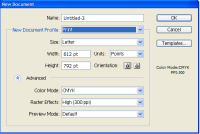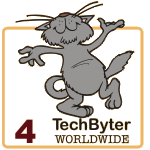|
|||||||||||||||||||||||||||||||||||||||||||||||||||||||||||||||||||||
| Previous page | Do you use a pop-up blocker? If so, please read this. | ||||||||||||||||||||||||||||||||||||||||||||||||||||||||||||||||||||
|
|||||||||||||||||||||||||||||||||||||||||||||||||||||||||||||||||||||
| Show Date: 2007.12.02 | |||||||||||||||||||||||||||||||||||||||||||||||||||||||||||||||||||||
A Corel Draw fan casts an eye on Adobe Illustrator CS3Let's take care of some caveats at the start: First, I'm a big fan of Corel Draw and I have been since it first appeared sometime in the early 1980s. I've considered Corel's "sparse tool set" that combines related tools under a single icon to be the best way to keep on-screen clutter down. And I've always felt that Adobe applications didn't make good use of screen real estate, dropping tools all over the place. Then CS3 came along. Every application in the suite has been subjected to major interface tuning and it shows. Overall, and as a non-designer, I'm still more comfortable with the Corel product, but this version of Illustrator is enough to make me sit up and pay attention. A new Color Guide feature generates entire color schemes based on a selected color. For people like me who have little or no sense of color compatibility and only the most rudimentary understanding of color theory, this is wonderful. Color Guide won't make me an award-winning designer, but it will keep me from making horrid color errors. I select a base color and tell Illustrator what kind of scheme I'm looking for (complementary, analogous, monochromatic, or triad) and I have tastefully matched colors with a single mouse-click. Specialized programs exist to develop color schemes, but I like having this feature built in to Illustrator.
On the other hand, one piece of the interface that didn't change disappointed me. Illustrator continues its standard method of applying colors and, compared to Corel Draw, it's clumsy. In Draw, I can apply fill and stroke (the outside line) colors in 3 clicks: Select the object, left-click for the fill color, and right-click for the stroke color. Done. With Illustrator, I have to select the object, click a tool to tell Illustrator whether I want to work with the stroke or the fill, then click the color on the palette. That doesn't seem like a big difference, but it seems inefficient. Adobe probably has a good reason for keeping some of the old methods such as this. People who have been using Illustrator through more than a dozen iterations would probably find it disconcerting to have the method changed at this late date. Illustrator also continues to have a Select tool and a Direct Select tool. I wonder if I'm the only user who has trouble figuring out which tool to use for what tasks. In many cases, it seems to matter little which one I choose. And there are special tools for free transform, scale, and rotate. Why? New to this version is an Eraser tool, which is causing about as much of a stir among Illustrator users as it did among Draw users when Corel introduced it several versions back. The Eraser works on whatever object is selected, so the user can simply select an object (both the Select and Direct Select tools do the same thing in this case) and start erasing. Unselected objects are left alone. What makes this so powerful is that the user can modify an image without having to concentrate on paths and anchor points. For Mac users who have computers with Intel processors, the upgrade is essential because Illustrator CS3 is a "universal binary application", which means that it will run at full speed on the new Macs. For Windows users, Illustrator CS3 is certified for both XP and Vista. Other feature I like are Document Profiles and Templates. If you create a lot of print documents, a single setting creates a letter-size page in CMYK colorspace with point measurements and 300dpi graphics. If you prefer measurements in inches and you normally create a horizontal tabloid page, you can set up your own profile that creates all of those settings. For more involved projects, there are templates that can include guides, graphics, text, and more. These are features that make the design process faster by eliminating much of the start-up preparation. Illustrator illustrated
What about Freehand?When Adobe acquired Macromedia, it also acquired Freehand. Although I always considered Freehand to be little more than an also-ran in the vector race, it did have a following. Adobe hasn't said much about Freehand's future and some people have suggested that Adobe will kill all products that compete with theirs (not likely) or that features from some Macromedia applications will be folded in to Adobe products (that seems like part of the answer.) My speculation is that Adobe will keep the strongest products (if that means Macromedia Dreamweaver will replace Adobe GoLive, so be it) and that features from the orphans will be added to the surviving applications. There are days when I wish that Adobe would acquire Corel to gain access to some of the interface features in Draw and some of the capabilities of Ventura Publisher. For those who are making the move from Freehand to Illustrator, I'm told by former Freehand users that importing their old Freehand files into Illustrator isn't as painful as they had feared. The import filter works well and most of the objects imported make the transition properly. For the first time in my life, I sometimes reach for Illustrator instead of Corel Draw
My brain and my hands are still too closely bound to Corel Draw to give Illustrator more than 4 cats, but that's a collossal change because at one time I loathed Illustrator. As recently as Illustrator CS2, I didn't think much of it. Current Illustrator users would probably award Adobe 5 cats, with a promise of additional litters, for the improvements in this version. If you're using Illustrator CS2, you'll be delighted. And if you're still using an earlier version of Illustrator, you'll be astonished by CS3. For more information, visit Adobe's website. “I want an operating system”If anything, it’s getting more difficult to pick an operating system. Buy a new Intel-based Mac and you can install Apple’s OS X, Microsoft’s Vista (4 versions) or XP, and Linux (dozens of variants). On a standard (that is, non-Apple) machine, you still can choose to mix and match the Microsoft operating systems and one or more versions of Linux. Linux is by far the most difficult decision to make because even if you limit the distributions you’ll consider to just those available in English, aimed at the general public for use on Intel-based machines, and maintained by the developer, you’ll have more than 50 choices. Widen the scope a bit and you could easily come up with a list of more than 200 Linux distributions. Which is right for you?The big categories first: Microsoft, Apple, or Linux. The best advice has always been to figure out what you want to use the computer for, identify the applications that will do the job, and then match the operating system and the hardware to the software. Today’s hardware and operating systems all have applications that do just about anything you might want to do. If you need to create professional videos, you’ll probably be using a Mac. If you’re developing games, you’ll find the most flexibility on a Windows machine (which could, of course, be a Mac). If you’re a scientist or you plan to run an Internet hosting company, you’ll want Linux machines. For most people, this is no longer a deciding factor. Even the look and feel of the operating system is less of a factor than it once was. Windows machines put the Task Bar at the bottom, but you can reposition it. Most Linux machines put the Panel at the top, but you can reposition it. Macs put the Dock at the bottom of the screen, but you can reposition it. All 3 operating systems have task switchers. Apples have widgets, Windows machines have gadgets, and Linux machines have desklets. All 3 operating systems have an icon or button you can click to minimize all applications so the desktop is visible. Disk drives in Windows have letters with associated names. Disk drives on Apple machines have names. Disk drives on Linux machines have mount points, but the operating system can make these appear as letters or named drives. All 3 operating systems can index any attached drives for faster searching. It goes on like that. The widest selection of commercial software is available for Windows machines (which, as I’ve mentioned, could be a Mac). Some applications run only under Windows. A few applications are available only on Macs. Linux systems run primarily open-source applications, which are similar to commercial applications (Open Office is like Microsoft Office, for example). If your work doesn’t depend on features of applications that are available only for Windows machines or Macs, Linux is a reasonable choice. Not that there’s any shortage of Windows snobs, Mac users seem to include a larger percentage of snobs and Linux users sometimes claim both a technological and moral supremacy over Mac and Windows users. But as I said, there’s plenty of snobbery to go around. Because of what I do, I get to play with Microsoft’s Vista and XP, with Apple’s Leopard, and with Ubuntu’s Gutsy Gibbon Linux. I see features in all of the operating systems that I like and I see shortcomings in each. When I encounter articles on a Mac-centric site that refer to Vista as an utter failure, I have to wonder what planet the writer lives on. Likewise, you’ll find anti-Mac articles written by Linux chauvinists. And, as I alluded to earlier, there’s no shortage of Windows wackos. Articles by these folks generate a lot of heat and are good for ratings, but they don’t create much light and they certainly don’t help people determine which operating system will be the best choice for their individual needs. You won’t find a perfect operating system, but whichever option you choose will be capable of handling just about anything you ask it to do. If money is no object, buy the fastest Intel-based Apple you can find, load it up with lots of memory and disk space, and install Vista and Linux along with Leopard. If money is a large object, a sub-$500 computer (including monitor, keyboard and mouse) with one of the Linux distributions will be more than adequate. This report was written and edited on a notebook computer running Open Office Writer on Ubuntu Linux, then prepared for the website in Adobe Dreamweaver CS3 under Microsoft XP, with final editing under Microsoft Vista. Some components were generated, edited, or prepared on a Mac running OS X 10.4. In the coming weeks, I plan to talk about operating systems a bit more than usual because for the first time in a long time computer users have several valid alternatives. Keep that foot elevated"You can go back to work, but keep the foot elevated as much as you can." That's the instruction I got following foot surgery. As I type this, my foot is elevated and bandaged. There is a shiny little pin sticking out of the fourth toe of my left foot and the pin extends the length of the toe and into the foot. Walking is a bit of a challenge, but working isn't. I wouldn't be working if I drove a fire engine, ran a crane, worked as a lineman (either for a football team or an electric utility), built houses, or carried the mail. Because I have a desk job, I can work. One problem is that my desk doesn't have anyplace where I can elevate my foot. The answer is homework.Or maybe "home work", to differentiate it from the bane of students all over the world. With a notebook computer, a WiFi connection (or even a wired connection), a comfy place to sit, and a place to elevate my foot, I can work and follow my doctor's instructions at the same time. Laptop computers come with eraser-head mice or glide-point mice. My old Toshiba has both and I don't like either one. I much prefer a real mouse. The problem with that is that it's next to impossible to balance a notebook computer on my lap and use a mouse. A couple of years ago, the folks at LaptopDesk.net sent one of their Laptop Desk devices for me to try out. I liked it because it insulated my lap from the heat of the notebook computer. Now I like it even more because it's wide enough for a mouse pad and a mouse. Thoughts of a first-time poll workerThis isn't specifically a technology report, but technology is a part of it. It's about voting, which has become increasingly technological. This year, I worked as the presiding judge in an Upper Arlington precinct. The presiding judge is required to be from the party that prevailed in the most recent gubernatorial election. The precinct I served in had helped to elect Ted Strickland governor. Yes, I'm a Democrat. The Republicans and independent I worked with on election day all wanted the same thing: An honest election. This is an important topic that transcends technology. That's why the account is part of this week's program. Four comes early, even for someone who routinely gets up at 5 and who spent a lot of years getting up at 4. Arriving at the precinct about 5:10, I was moments behind the presiding judge for another precinct. Two other judges, one from my precinct, were already there. All of my judges, including the "Youth at the Booth" high school senior who was to be my machine judge showed up on time. The machine judge started setting up the machines. Clearly, he had paid close attention during the training. We were ready to go by 6:15 and handled a small flurry of voters at 6:30. Then we moved the machines around a bit to make them more private. Voters still complain about the lack of curtains, but the machine can be positioned so that nobody else can see the screen. We averaged about one voter every 3 minutes throughout the day, with occasional lulls and occasional lines. One of the other precincts in the room had nearly continuous trouble with 2 of the 5 voting machines. We experienced a brief problem with one of our three machines. The third precinct in the room had no problems. A voter reported that she was having a problem with the school board race in which 3 candidates were running and the voter could select up to 3 candidates. She had voted for fewer than 3, so the review screen indicated an undervote; but then it showed no selections for any of the school board candidates. With the assistance of another judge from the other party, we cancelled the ballot and asked the voter to try again on the same machine. When she got the same results, we cancelled that ballot and asked her to vote at another machine, where she had no problem. I called the Board of Elections and was told to close the machine. A technician was dispatched, but a roving technician arrived a few minutes later and reset the machine. This involved removing the protective seal on the memory card compartment, so we had to keep track of the old seal and the new seal. We warned the next 6 voters about the problem the machine had displayed and asked them to watch carefully for the problem. Nobody reported a problem, so we considered that the repair had been a success. At 7:30, the judges performed the closing procedure and I left for the board of elections warehouse shortly after 8. With 750 vehicles converging on a warehouse served by a single-lane access road, I expected a delay. The process of dropping off supplies took less than 5 minutes because the system is set up to handle approximately 10 vehicles at a time. I was home by 9pm. SecurityThe machines are delivered in locked security cases. The cases are made of plastic pipe, which is easy to cut. That would be pretty obvious, though. They are locked and the locks have security tape on them. If they've been tampered with, that would also be obvious. The machines come with the paper tapes already installed in a compartment that is locked and sealed with a security tape. The flash memory card is already in the machine—in a compartment that is protected by a security tape. At the end of the day, the paper tape stays with the machine, while the flash memory and the personal electronic ballot (PEB) are returned to the board of elections by the presiding judge. Enough people are present at every step that vote tampering would be extremely difficult at best. My primary concern about accuracy has never been at the precinct level. Counties vary. I believe that Franklin County is one of the better operations both in terms of efficiency and in terms of honesty. It's the Secretary of State who can, by certain actions or inactions, affect the results. More troubling is the lack of transparency when it comes to the software that runs the voting machines and the tabulating machines. No matter how honest precinct poll workers are, no matter how honest county boards of elections are, and no matter how honest secretaries of state are, the programming that controls the voting machines and the tabulation of votes following the election are places where "something" can happen. I trust the machines, though. It would be difficult to tamper with the real-time audit log (RTAL) paper tape, the personal electronic ballot (PEB), the flash memory, and the tapes posted a precincts in a way that the results would all check out after the election. To tamper with votes, someone would need to intercept the presiding judge who carries the flash memory cards, a paper summary tape, and the master PEB back to the board of elections while simultaneously managing to modify paper tapes that are stored in locked cabinets and that may additionally be locked inside a voting machine. We all watch each other too closely—and we're all too interested in having a fair election—for that to happen. The peopleThe presiding judge (me) in this precinct is a Democrat because this precinct voted for the Democrat who was running for governor a year ago. I don't understand this. Other judges in the precinct had more experience than I do and would probably have done a better job as PJ. The PJ doesn't have any special powers and isn't capable of influencing the election. Simply put, it's the PJ who is "in charge" of the other judges, but no judge will do anything improper regardless of who issues the command. So the PJ's responsibilities, other than driving the results back to the warehouse, are to call the board of elections to report any problem. It seems to me that the most experienced poll worker, regardless of affiliation, should be the PJ. And what about "independent" voters. The PJ must be a Republican or a Democrat. The dual-party system has ensured that nobody else can be the PJ. Why? If the most experienced judge in the precinct is a member of some other party, why should that person not be the PJ? The current system smacks of the "spoils" system and in excludes those who are not members of the two "main" parties. (Judges can be from any party, but the PJ must be from one of the two "major" parties.) The process and the costWashington State will transition to a vote-by-mail system next year, essentially making everyone an absentee voter. Some parts of other states allow voters to cast ballots anywhere in the county. Maybe it's time for a change. Consider "my" precinct. We have about 525 registered voters. Around 225 voted in person and another 30 or so cast absentee ballots. The precinct has 6 judges, each of which earns about $100 for the day. The board of elections may pay something for the polling place, but let's assume that it's free. The voting machines must cost at least $1000 each, so I'll say that they cost $100 in the assumption that they will be used for at least 10 elections. Let's assume that transporting the machines in their special security cages from the board of elections and back again is only $50 per machine and let's assume that the supplies (flags, scissors, pens, tapes, signs, lost-voter lookup books, voter signature books, and other materials) cost just $25 per machine. Making those assumptions, the cost to Franklin County for the 225 votes cast at the precinct is $1125, or about $5 per voter. Is that too much, too little, or about right? Who should pay? Clearly, it's the taxpayer who ultimately pays, but should it be a federal commitment, a state commitment, or a county commitment? Would it cost less (or be more fair) if Ohio followed the lead of Washington State in mailing paper ballots to all qualified voters? That's a good question, even if I did ask it myself. Would paper ballots for everyone be more accurate? More fair? Less expensive? Five dollars per voter seems like a lot, and that amount leaves out the cost of tabulating votes at the county board of elections and the state board of elections. I'm not sure that paper ballots would be any more fair, any more secure, or any more fair. Nerdly NewsSearching safelyWhen you use a search engine to look for something, you'd like to think that the search engine will return only clean sites, but you really can't count on that. Sunbelt Software has been investigating search engine optimization (SEO) "poisoning" for months and released a lot of information on the topic this past Monday. By Wednesday, Google had purged thousands of sites that served malware to unwary searchers. The only problem is that Google won't admit that it did the right thing. Google is big. Google is powerful. Google does a lot of good things. But sometimes Google, despite its effort to hire only geniuses, does some astonishingly dumb things. Computerworld tried to get Google to admit that they'd done tie right thing, but "Google itself refused to confirm or deny that it had cleansed its index of the more than 40,000 malware hosting sites, or even that they had existed." I've tried to communicate with Google's PR folks in the past. They don't take phone calls, at least not from me. Apparently not from Computerworld, either. Computerworld wrote: "Google takes the security of our users very seriously, especially when it comes to malware," a company spokeswoman said today in an e-mail. "In our search results, we try to warn users of potentially dangerous sites when we know of them. Sites that clearly exploit browser security holes to install software, such as malware, spyware, viruses, adware and Trojan horses, are in violation of the Google quality guidelines and may be removed from Google's index." I have to wonder what the reaction would be if Microsoft or Apple behaved this way. Why does Google continue to get away with the secrecy? Is it because they're not evil? They're not doing nothingBut the FBI has been going after creeps who run "botnets" and has just managed to get eight people indicted. Yes, eight. That's great, but at this rate it will be sometime after 2372 that they'll all be caught. And chances are that they'll die of old age long before 2100. The eight are thought to have been responsible for infecting one million computers and running scams that cost victims more than $20 million. Besides the 8 who have been—some of whom have been indicted, while others have been sentenced to prison—13 search warrants have been served in the US and elsewhere. So that's a grand total of 21 people who might do a little time for ripping off $20 million. The FBI identifies the miscreants thusly:
The FBI called it "Bot Roast II". Those who run botnets gain control of computers by using malicious software and then use them for illegal purposes. Earlier in the year, the FBI conducted the first Bot Roast, which identified over 1 million botnet crime victims. The FBI will continue to work on the problem, but for your own safety, it's up to you not to click on suspicious links. Until proven otherwise, all links are suspicious. |
|||||||||||||||||||||||||||||||||||||||||||||||||||||||||||||||||||||
|
|||||||||||||||||||||||||||||||||||||||||||||||||||||||||||||||||||||
| Home • Programs • Reference • Subscribe to Technology Corner News • Contact Us • Terms of Use ©2007 by William Blinn Communications. All rights reserved. |
|||||||||||||||||||||||||||||||||||||||||||||||||||||||||||||||||||||
This is the only ad you'll ever see on this site. It's for my website host, BlueHost in Orem, Utah. Over the past several years, they have proven to be honest, reliable, and progressive. If you need to host a website, please click the banner below to see what BlueHost has to offer. |
|||||||||||||||||||||||||||||||||||||||||||||||||||||||||||||||||||||

|
|||||||||||||||||||||||||||||||||||||||||||||||||||||||||||||||||||||

